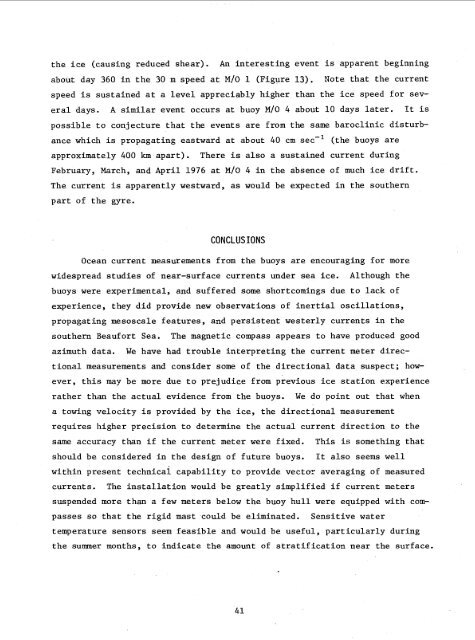AIDJEX Bulletin #40 - Polar Science Center - University of Washington
AIDJEX Bulletin #40 - Polar Science Center - University of Washington
AIDJEX Bulletin #40 - Polar Science Center - University of Washington
You also want an ePaper? Increase the reach of your titles
YUMPU automatically turns print PDFs into web optimized ePapers that Google loves.
the ice (causing reduced shear). An interesting event is apparent beginning<br />
about day 360 in the 30 m speed at M/O 1 (Figure 13). Note that the current<br />
speed is sustained at a level appreciably higher than the ice speed for several<br />
days. A similar event occurs at buoy M/O 4 about 10 days later. It is<br />
possible to conjecture that the events are from the same baroclinic disturbance<br />
which is propagating eastward at about 40 cm sec-l (the buoys are<br />
approximately 400 km apart). There is also a sustained current during<br />
February, March, and April 1976 at M/O 4 in the absence <strong>of</strong> much ice drift.<br />
The current is apparently westward, as would be expected in the southern<br />
part <strong>of</strong> the gyre.<br />
CONCLUSIONS<br />
Ocean current measurements from the buoys are encouraging for more<br />
widespread studies <strong>of</strong> near-surface currents under sea ice. Although the<br />
buoys were experimental, and suffered some shortcomings due to lack <strong>of</strong><br />
experience, they did provide new observations <strong>of</strong> inertial oscillations,<br />
propagating mesoscale features, and persistent westerly currents in the<br />
southern Beaufort Sea. The magnetic compass appears to have produced good<br />
azimuth data. We have had trouble interpreting the current meter directional<br />
measurements and consider some <strong>of</strong> the directional data suspect; however,<br />
this may be more due to prejudice from previous ice station experience<br />
rather than the actual evidence from the buoys. We do point out that when<br />
a towing velocity is provided by the ice, the directional measurement<br />
requires higher precision to determine the actual current direction to the<br />
same accuracy than if the current meter were fixed. This is something that<br />
should be considered in the design <strong>of</strong> future buoys. It also seems well<br />
within present technical capability to provide vectoT averaging <strong>of</strong> measured<br />
currents. The installation would be greatly simplified if current meters<br />
suspended more than a €ew meters below the buoy hull were equipped with compasses<br />
so that the rigid mast could be eliminated. Sensitive water<br />
temperature sensors seem feasible and would be useful, particularly during<br />
the summer months, to indicate the amount <strong>of</strong> stratification near the surface.<br />
41








